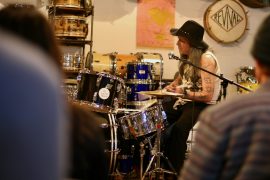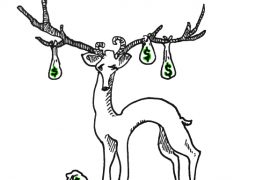My husband is Irish. Once a year, we drop a salty brisket, known as corned beef, into a pot of boiling water and cook it for many hours. We add in some green cabbage during the last hour. The corned beef is cooked until it falls apart with the gentle tug of a fork. This meat is so salty that I usually wake up bloated the next morning, but this may be a side effect of green beer consumption– yes, I said green beer. The good news is that we only eat this once a year. We often enjoy it with a side of soda bread, accompanied by many Irish and non-Irish friends toasting our commonalities and breaking down our ontological divide.
If we go out for pre-dinner drinks, we might go to Dullahan’s Irish pub and order Guinness Stout beer. The beer is typically served with a large foamy head on top and an artistically created four-leaf clover ‘drawn’ into the foam. This makes us smile; we recognize the clover as a symbol of our community, Irishness, and shared past histories. Janet Chrzan says in her 2012 book Alcohol, Social Drinking in Cultural Context, “Alcohol was also used to strengthen social ties; the sense of togetherness found in the modern pub has a deep history in Western Europe, from the Greek symposia to Celtic banquets.” And, currently in Portland, too!
St. Patrick’s Day is a celebration of heritage and nationality, occurring during the often-cold, dark month of March. As some say, we are ALL Irish on St. Patrick’s Day, but the truth is that those who have ancestral roots in Ireland have a stronger tie to each other and the celebrational meaning. On the other hand, by sharing in these experiences, the non-Irish are being brought into the community and becoming members of our consanguine sphere.
During this day, the Irish are expected to celebrate with much imbibing. And this has been common throughout history, as Chrzan notes, “But the lord of Hochdorf had nine, and we can imagine this chief in the center of his loyal warriors downing the contents of his 5-liter horn and daring his vassals to attempt his feat – to prove their might – by drinking as deeply and quickly as he can.” This noble feat is often repeated in modern pubs today, such as Kells Irish Pub on 2nd avenue in Portland.
Many diasporic Irish immigrants in the United States come together as a commensal community on this celebratory day, by eating and drinking typical food–sharing consumption– thus linking food, religion, community, and social-political memories.
Does our meal in America simulate that of Ireland? This is a question of ‘Emergent Authenticity’ answered by Cohen in his 1988 article, Authenticity and Commoditization in Tourism, Annals of Tourism Research: “Which is at one point generally judged as contrived or inauthentic may, in the course of time, become generally recognized as authentic.” So perhaps someday, all of our corned beef ‘n cabbage meals may be identified as authentic. Either way, we are still planning to eat our corned beef ’n cabbage and drink green beer!
Sadly, Liam Stack of NYT tells us that our traditional Irish meal might not be so Irish after all, ”But some Irish Americans might be surprised by another entry on that list of suspect foods: corned beef and cabbage. Experts say the meal originated on American soil in the late 19th century as Irish immigrants substituted corned beef for bacon, which was the meat of choice in the homeland.”
The truth is that there will likely always be Irish-Americans and Irish born and raised in Ireland; they might be temporarily brought together during cultural celebrations, but they are disparate, albeit in their culinary experiences of the day. Their political and social divides still exist.
Perhaps our Portland-based, St. Patrick’s day meal will bring us together socially and politically, at least for a day.
In conclusion, St. Patrick’s Day will always hold a special place in my heart. As a redhead and a subjugated (married into) Irish citizen, I will claim this celebration along with all the others that claim they are “Irish for the Day,” and happily eat my corned beef ‘n cabbage and drink my green beer.





